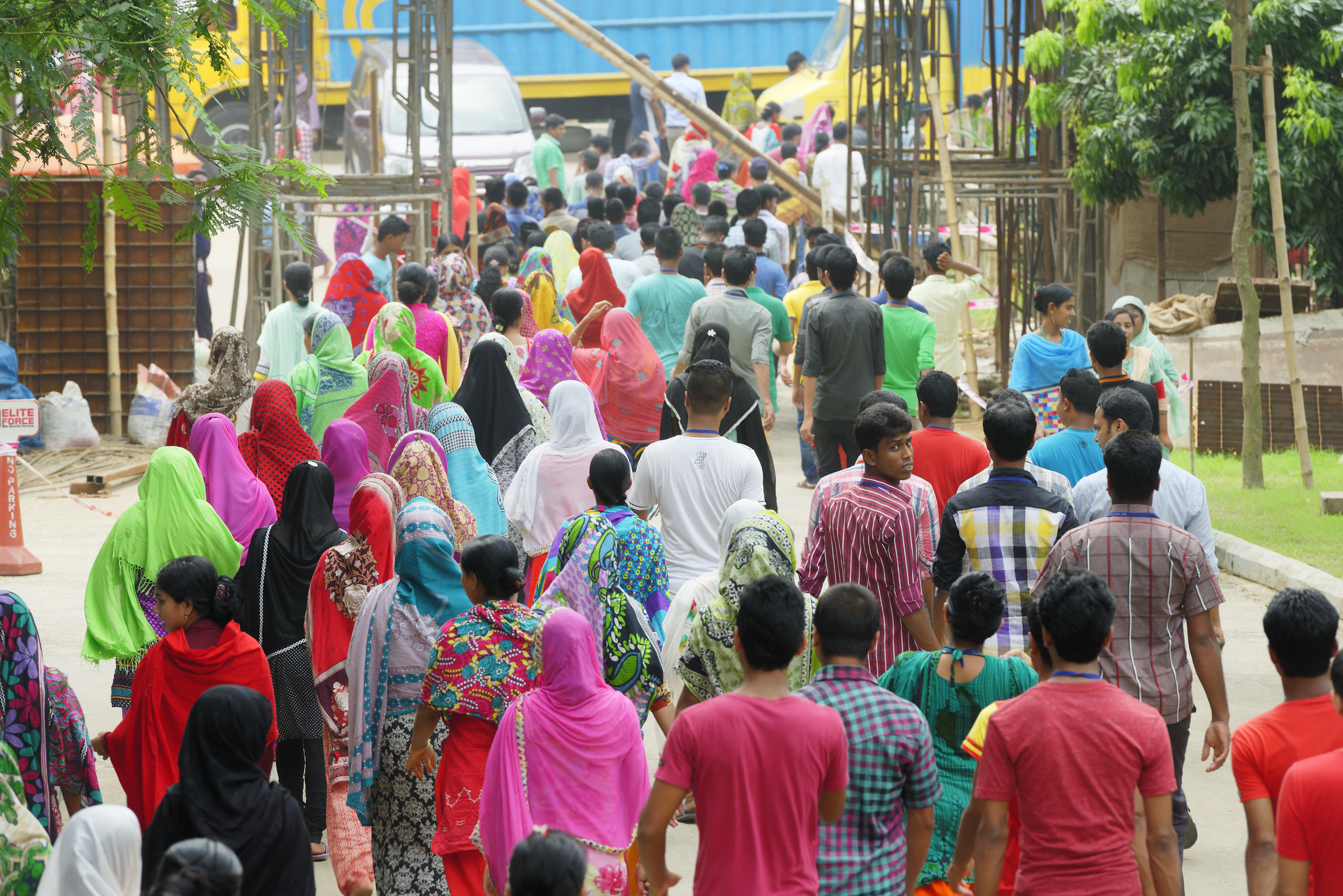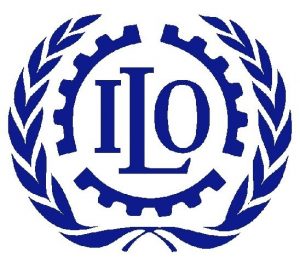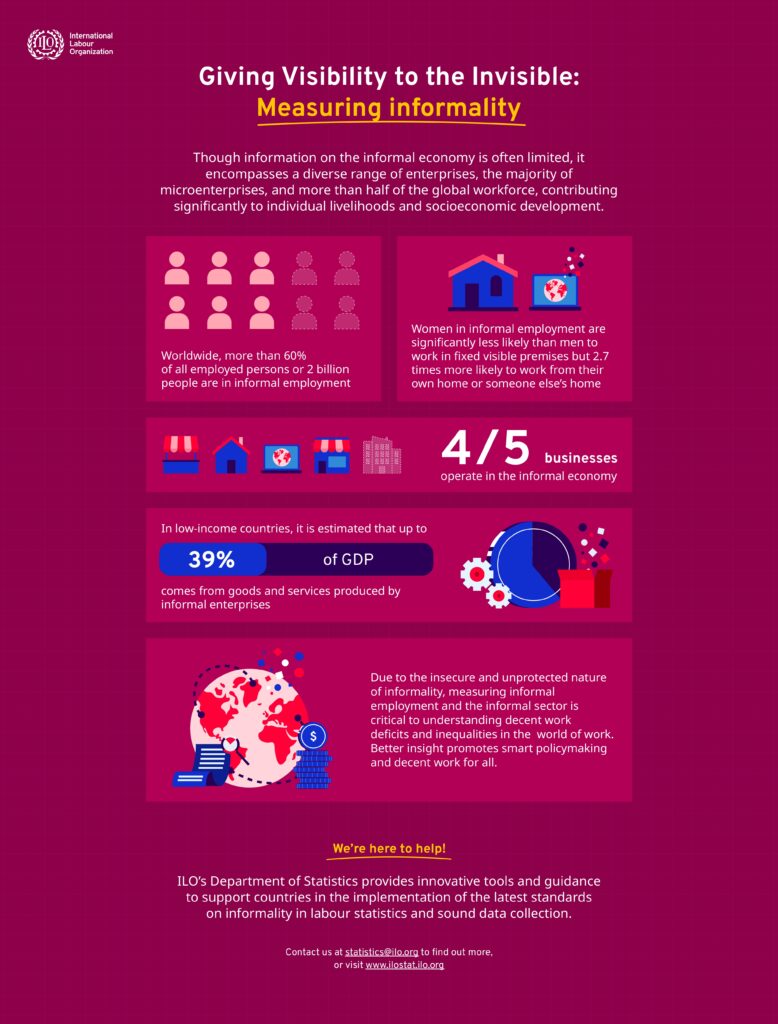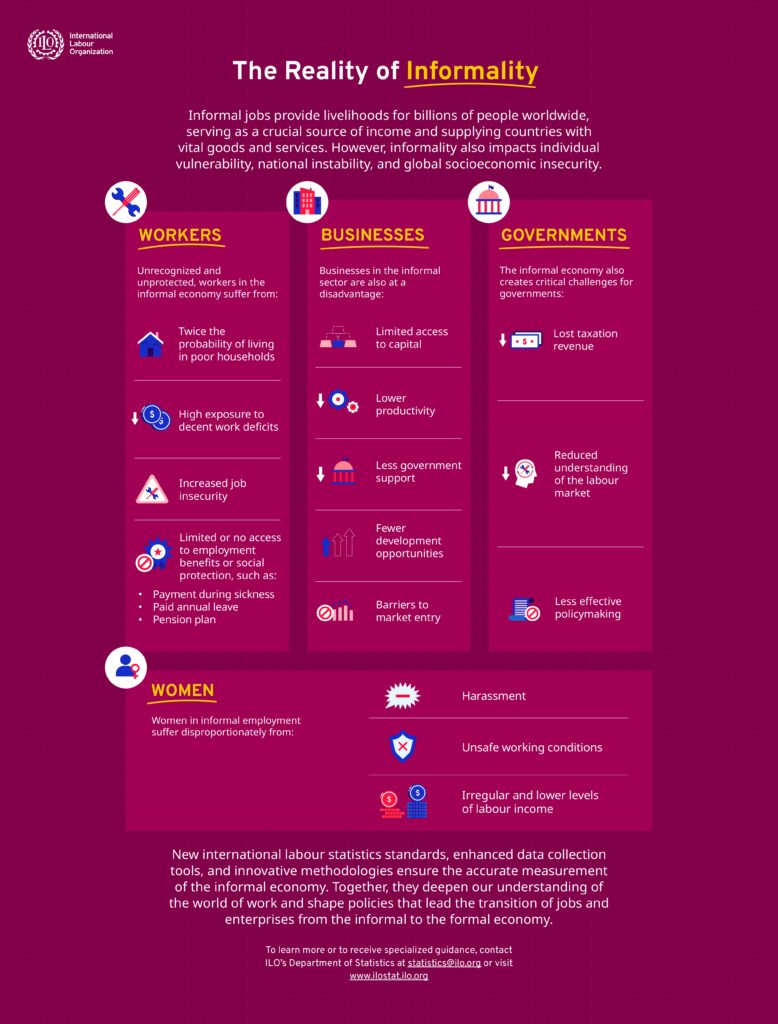Introduction
In many countries, the informal economy represents a significant part of the labour market and plays a major role in production, employment creation and income generation. However, informality puts workers at a higher risk of vulnerability and precariousness. It has a strong adverse impact on the adequacy of earnings, occupational safety and health and working conditions in general.
Informality remains a key concern of the Decent Work Agenda and the 2030 Agenda for Sustainable Development (the informality rate is part of the indicators selected to measure progress towards the Sustainable Development Goals, as SDG indicator 8.3.1). Addressing informality is also critical for women’s economic empowerment and gender equality.
In 2023, the 21st International Conference of Labour Statisticians (ICLS) adopted a resolution updating and improving measurement standards on the informal economy, not only to reflect latest world of work developments and provide a better reflection of people’s situation but also to align them to recent standards on the measurement of all forms of work (not only employment) and work relationships adopted by the 19th and 20th ICLS.
Recognizing that there is informality in all countries (regardless of their level of income and development), in economic units of the informal sector as well as the formal sector, and in households, the new standards provide operational definitions of the formal sector, the informal sector, and the household own-use and community sector based on the formal status of the economic unit and the intended destination of the production. They also introduce the concept of “informal productive activities” designating all productive activities carried out by persons or economic units that are – in law or in practice – not covered by formal arrangements, recognizing that productive activities can be “partly” informal.
In short, the informal economy includes all informal productive activities of persons and economic units.
Informal Economy Indicator Framework
Introduced by the 2023 resolution, it aims to support policy development and monitoring, research, and analysis, as discussed here. The ILO has developed an Indicator Selection Tool (still in its beta version) to search through the Informal Economy Indicator Framework.
Latest posts
Projects
In early 2021, the ILO Statistics Department started a three-year project to engender informality statistics, funded by the Bill & Melinda Gates Foundation. The project is running in parallel to the broader review of standards for informality statistics, currently undertaken through the ILO's Working Group on the Review of Informality Statistics. It supports integration of gender in the new standards, and the development of gender-related guidance and tools for measuring informality.
The main activity of the project is to test statistical concepts and household survey questionnaires, using cognitive interviewing in two countries in 2021 and a pilot field test in one country in 2022. The findings from those tests will support the working group in its discussions and drafting of the new standards, to be adopted by the 21st ICLS in 2023.
The project is also assessing the existing and anticipated needs for gender data on informality (data demand) and reviewing the use of data in strategy setting and policy formulation, making recommendations to strengthen the production, accessibility and use of gender statistics on informality.
For more information, please contact Jessica Gardner, Department of Statistics (gardner@ilo.org).
Methods
Adopted in 1993 and 2003, the current statistical standards for measuring the informal economy need updating. They are out of sync with more recent international standards for measuring work. The 20th International Conference of Labour Statisticians (ICLS) established a working group in 2018 to develop a new conceptual framework for measuring informality (see para 124). The 21st ICLS in 2023 will discuss and adopt the new standards. A comprehensive set of tools and indicators will guide production, analysis and use of the data.
Coordinated by the ILO, the Working Group on the Review of Informality Statistics includes representatives from national statistical systems, international agencies and development partners. It meets annually with four subgroups established to support the work in between annual sessions.
For more information, please contact Michael Frosch, Department of Statistics (frosch@ilo.org).
Reports and other relevant resources
- Discussion paper
- Meeting 1 report
- Meeting 2 report
- Conceptual framework draft (ver. 27_08_2021)
- Draft Resolution concerning Statistics on the Informal Economy
- Informal Economy Indicator Framework Selection Tool
List of working group countries and agencies
Countries
Argentina, Brazil, Chile, China, Colombia, Dominican Republic, Ecuador, Gambia, Ghana, India, Indonesia, Italy, Jordan, Lebanon, Malaysia, Mexico, Mongolia, Montenegro, Morocco, Nigeria, Oman, Pakistan, Palestine, Peru, Philippines, Poland, Saudi Arabia, South Africa, Sri Lanka, Thailand, Tunisia, Uganda, Vietnam
Observers
AFRISTAT, DIAL, GCC-STAT, CISSTAT, DATA 2X, EUROFOUND, EUROSTAT, FAO, OECD, IMF, SPC, UNHCR, UN Statistics Division, UN Women, WIEGO, World Bank

Labour Force Statistics (LFS, STLFS, RURBAN databases)
Concise description of concepts and definitions, uses, sources and limitations for labour force statistics in various databases (LFS, STLFS, RURBAN).

Labour Market-Related SDG Indicators (ILOSDG database)
Concise description of concepts and definitions, uses, sources and limitations for labour market-related sustainable development indicators.

Resolution concerning statistics on the informal economy
This resolution aims to set standards for statistics on the informal economy. It defines the statistical concepts of informal productive activities, the informal economy, the informal market economy and informal work and provides operational concepts, definitions and guidelines for the statistical measurement of its components.

Engendering informality statistics: gaps and opportunities
This working paper explores the demand for gender data on informality and the measurement challenges faced, and highlights the opportunities emerging from the revision of statistical standards on informality that are set to be adopted in 2023.

Measuring informality: A statistical manual on the informal sector and informal employment
This manual is intended for national statistical offices and other producers of statistics planning programmes to produce statistics on the informal sector and informal employment. The manual provides technical guidance on implementing international standards, presenting alternative measurement methodologies along with examples based on national experience, and includes guidelines for the dissemination of statistics on the informal sector and informal employment.


Measuring the non-observed economy. A handbook
The main focus of the Handbook is to provide guidance on how to produce exhaustive estimates of GDP. This means ensuring that as many productive activities as possible are observed, i.e., directly measured in the basic data on production, incomes, and expenditures from which the national accounts are compiled. It also means ensuring that non-observed activities are nevertheless accounted for, i.e., indirectly measured during compilation of the national accounts.

Resolution concerning statistics of employment in the informal sector
Adopted by the 15th ICLS (1993), this resolution provides technical guidelines as a basis for the development of suitable definitions and classifications of informal sector activities and the design of appropriate data collection methods and programmes, in the hopes such standards will enhance the international comparability of statistics.
Analytical publications
Note: Many publications are available only in English. If available in other languages, a new page will open displaying these options.






